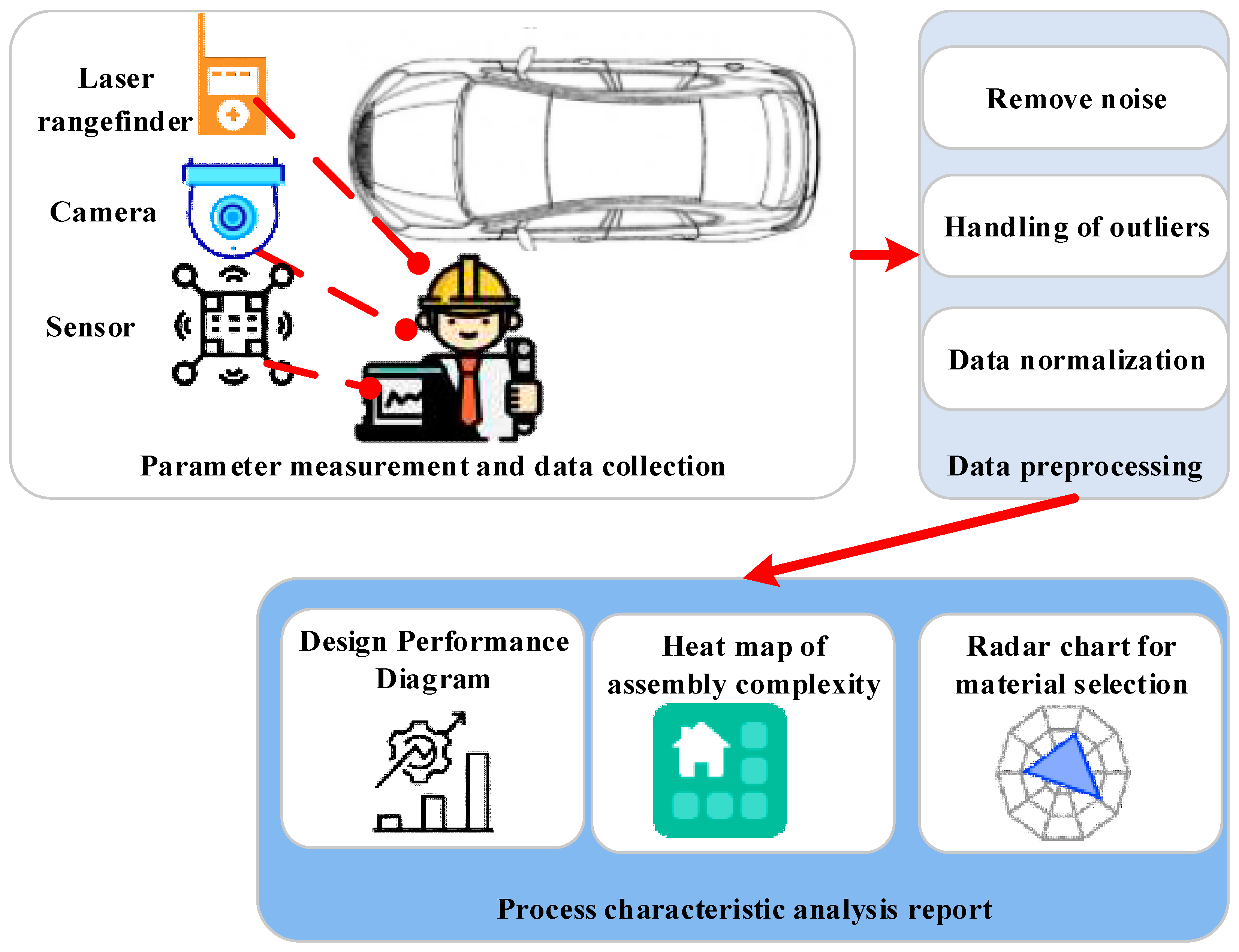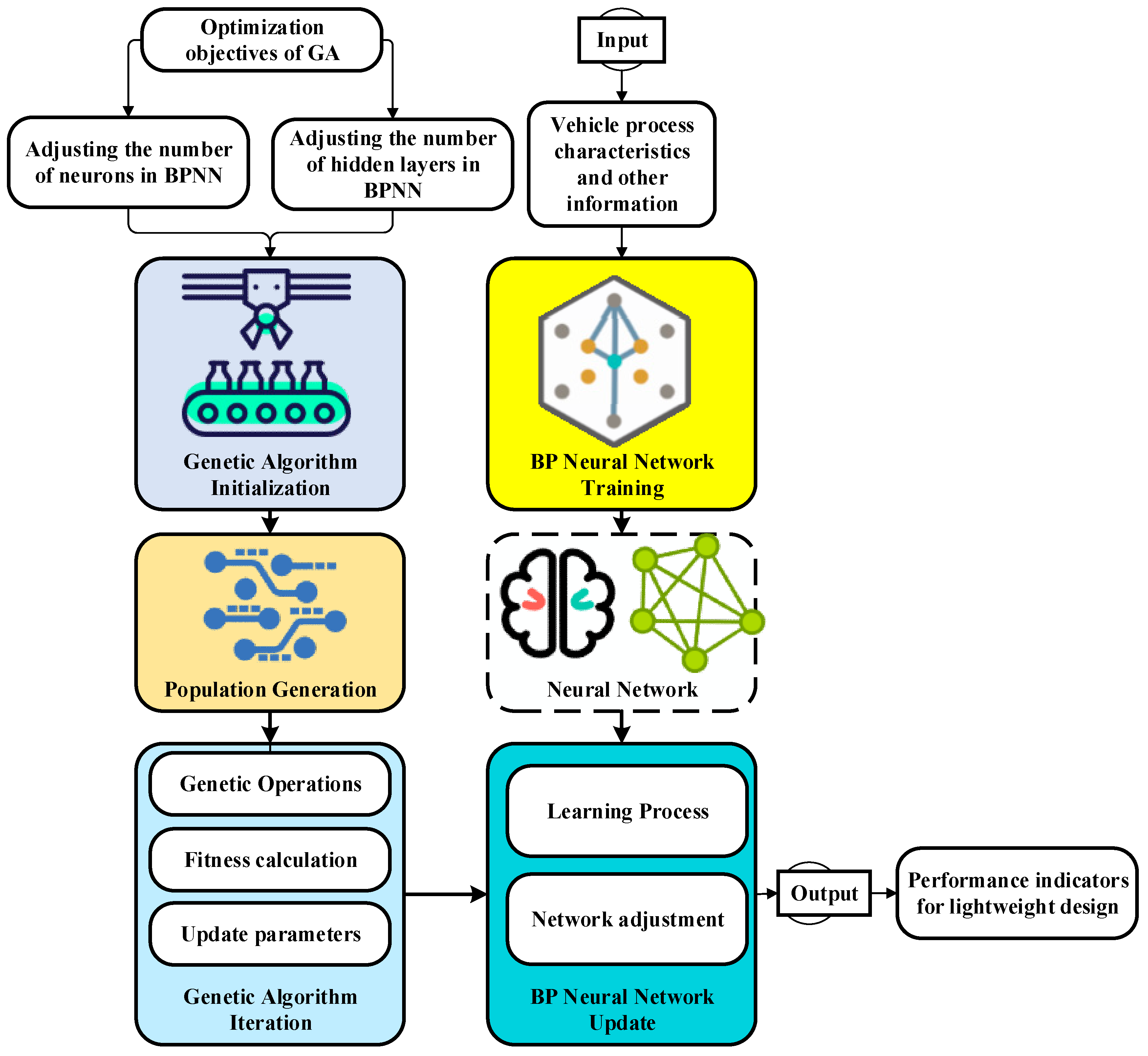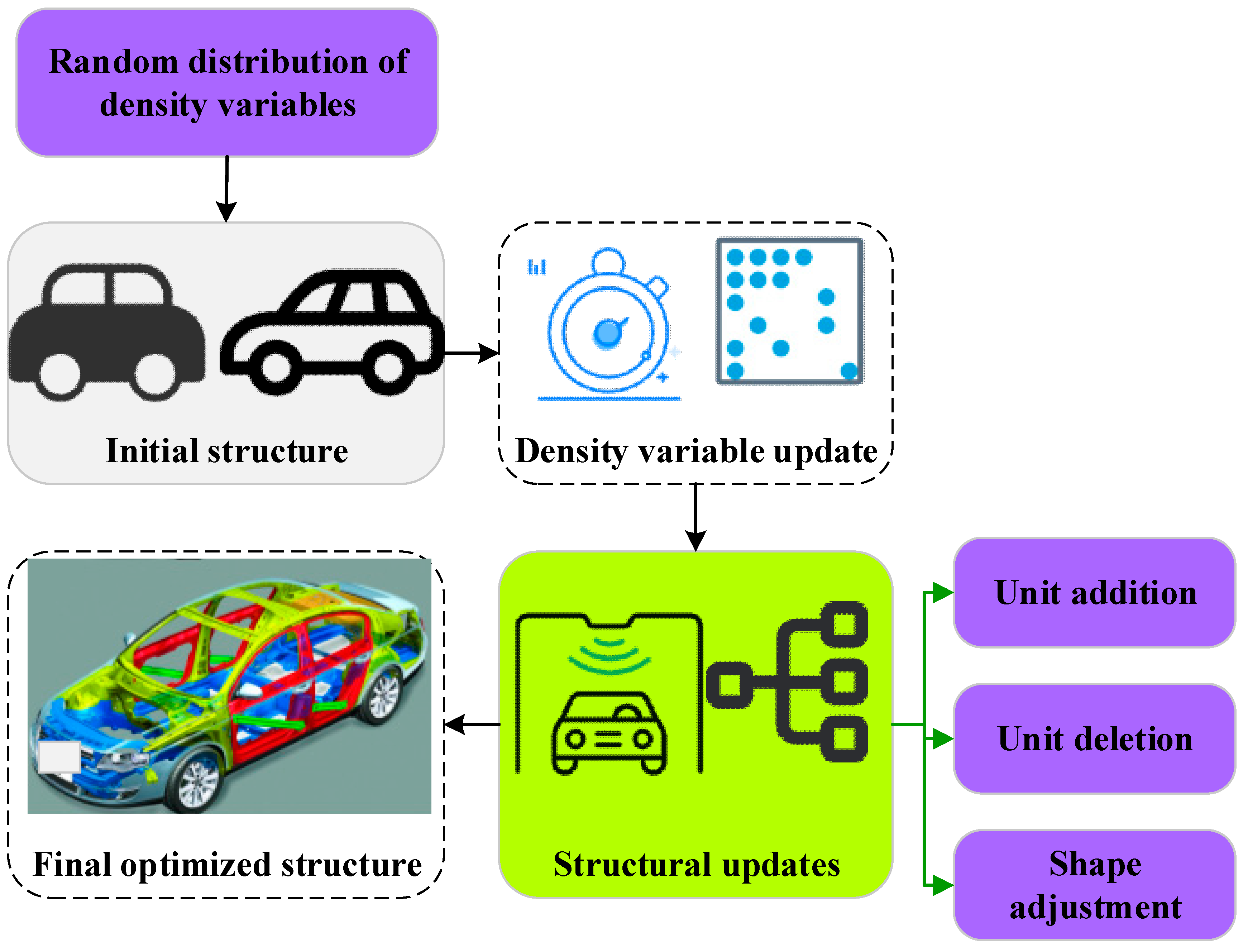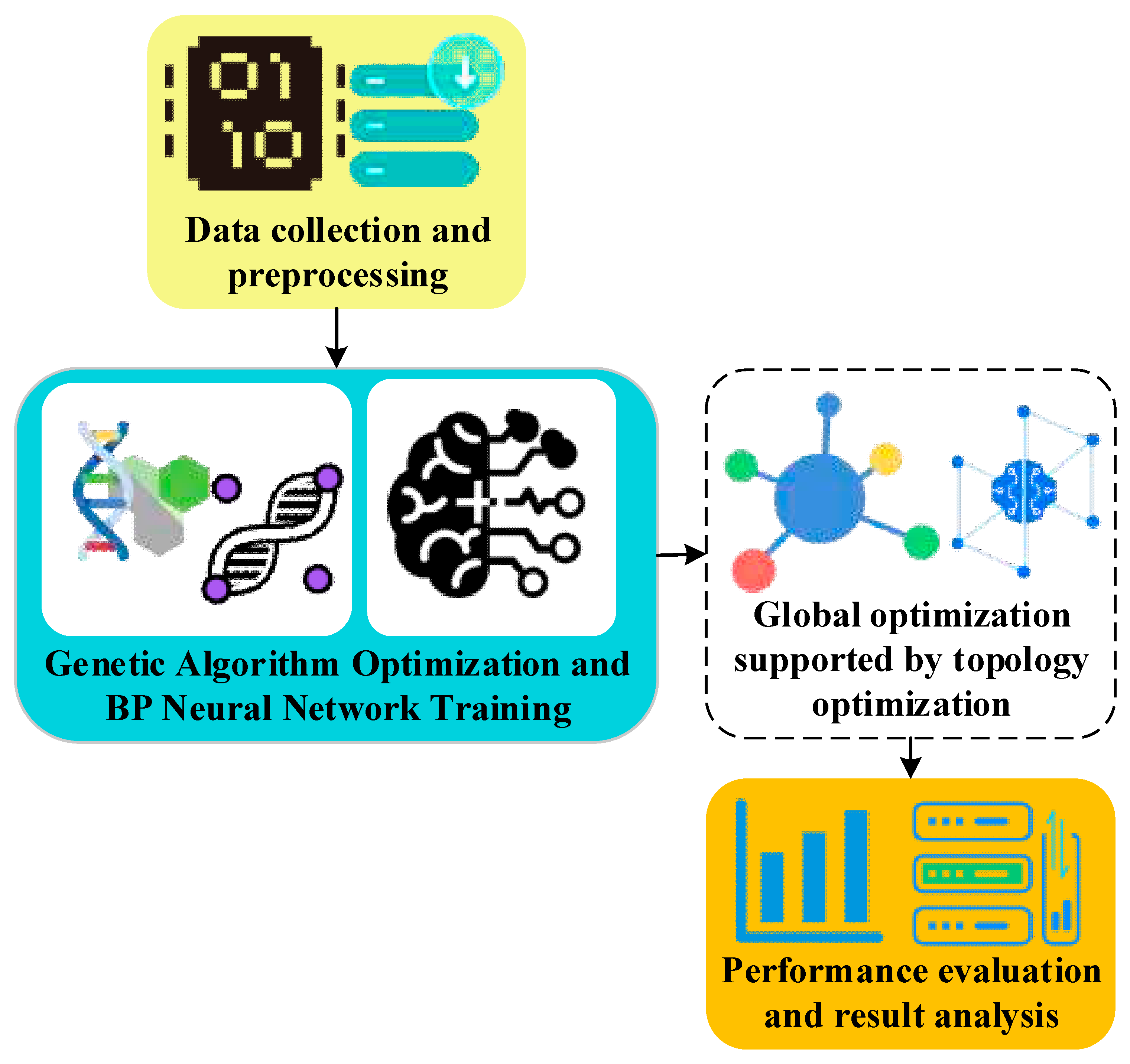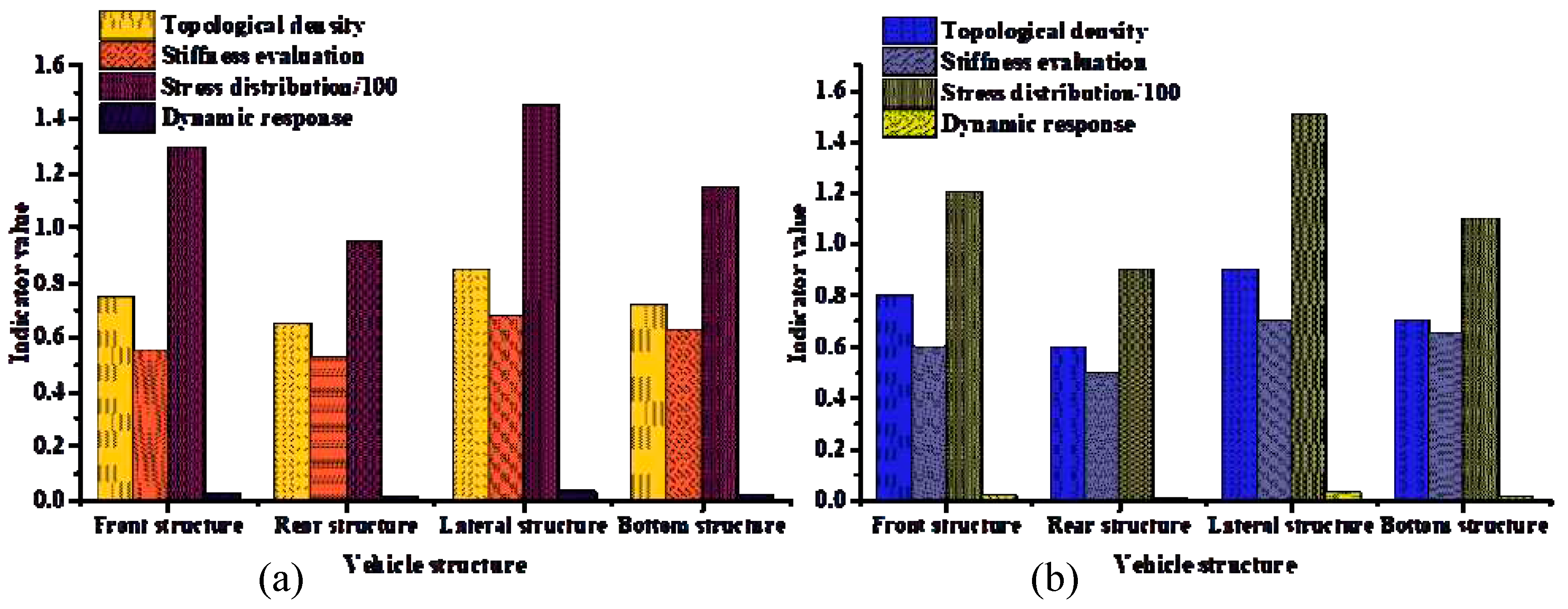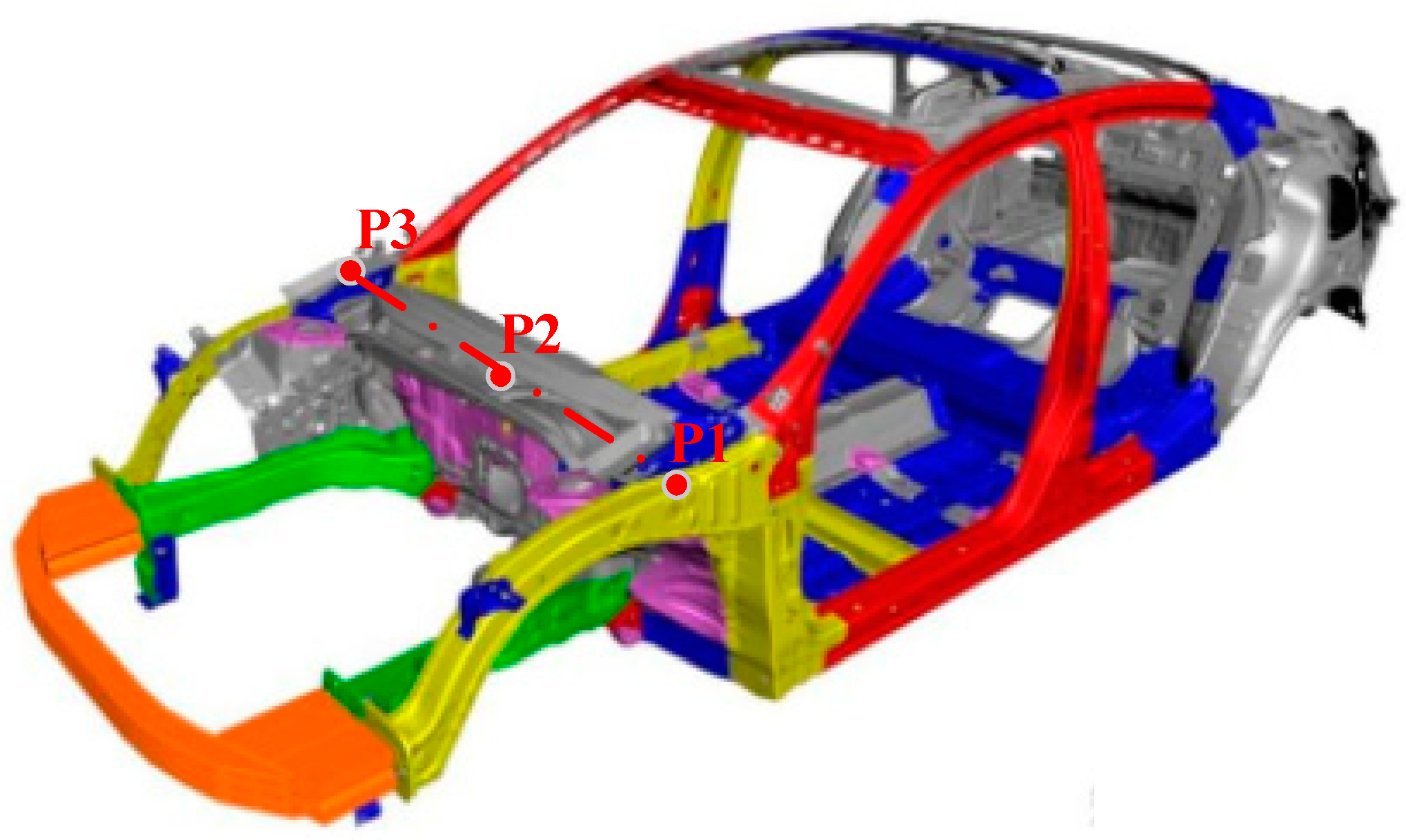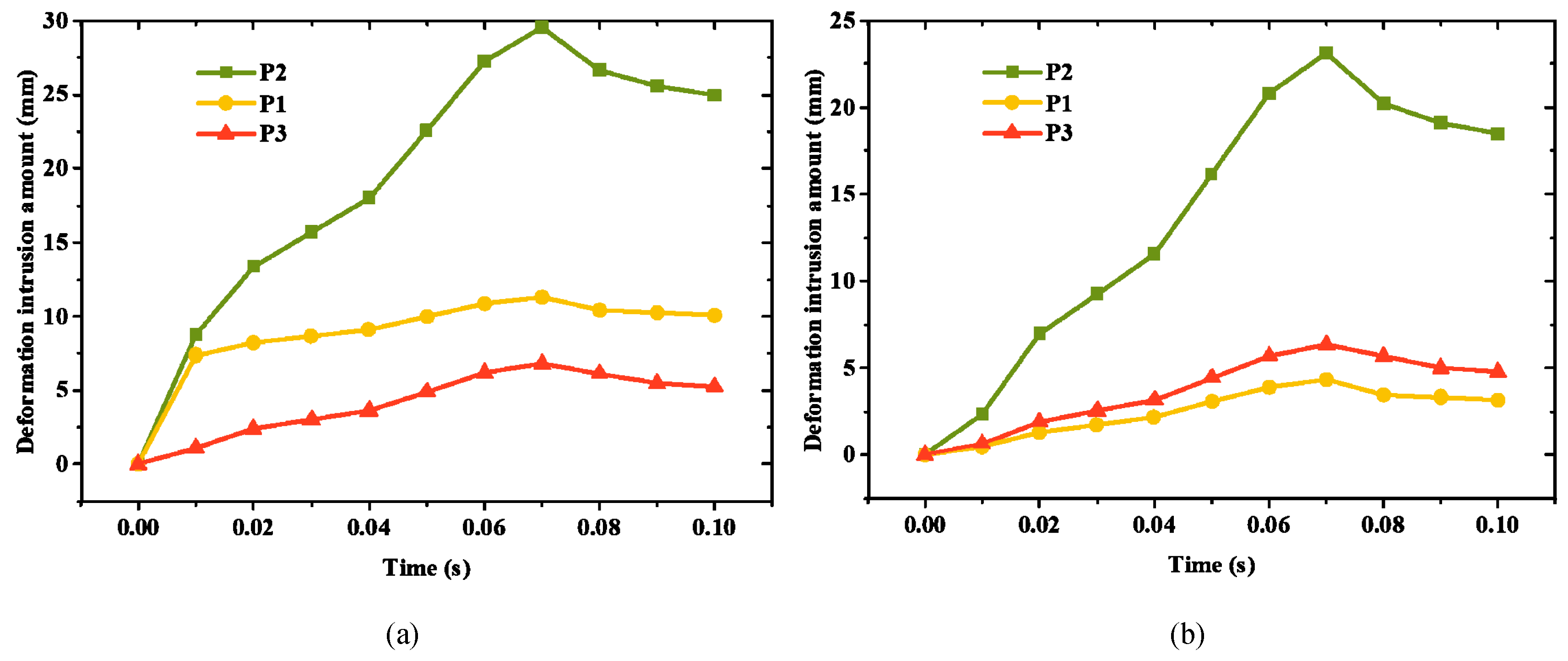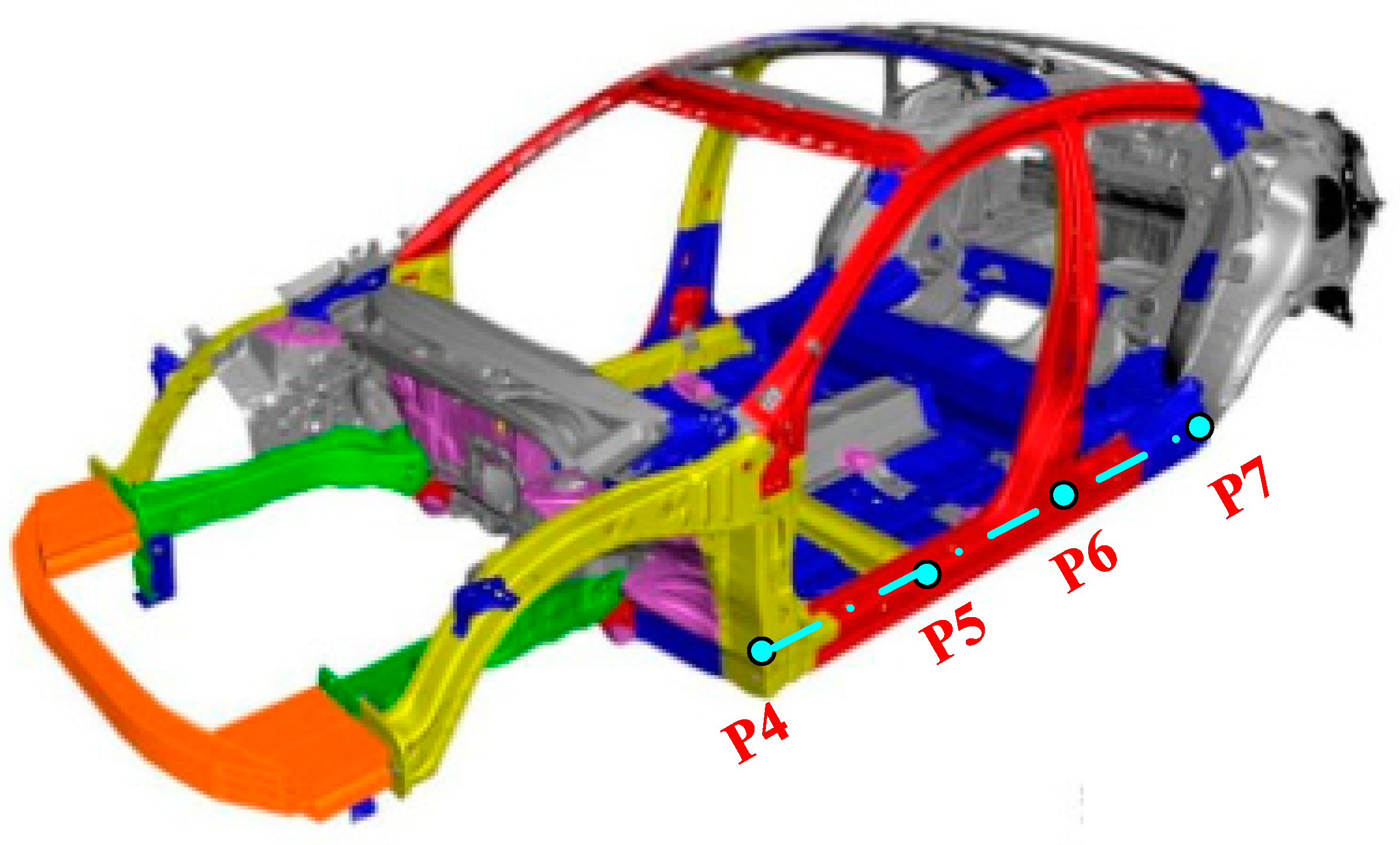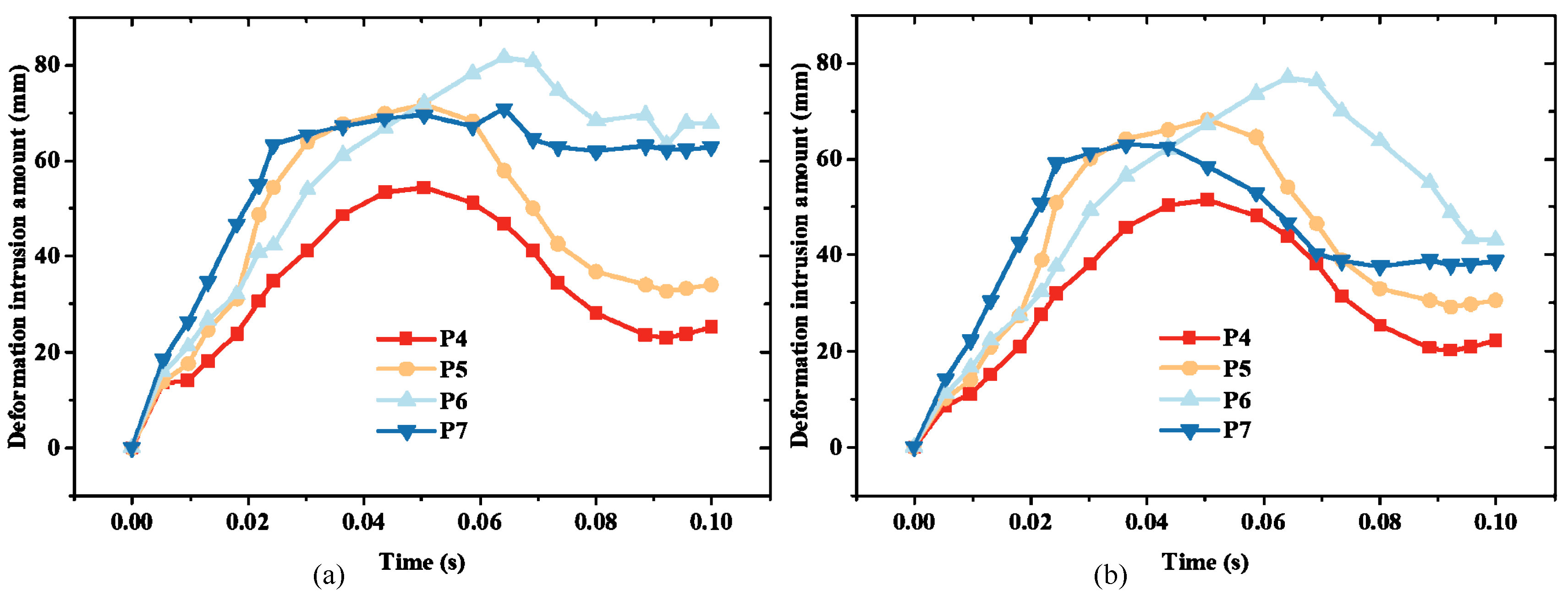1. Introduction
With the vigorous development of the global automobile industry, the lightweight design of vehicle technology has gradually become a key trend to lead the innovation in the field of automobile engineering [
1,
2,
3]. In modern society, higher requirements are put forward for vehicle performance, fuel efficiency and environmental friendliness, and lightweight design is considered as one of the core strategies to achieve these goals [
4,
5,
6]. However, with the increasing complexity of automobile design and the increasingly strict environmental regulations, the traditional design methods are facing many challenges [
7,
8]. It includes the inefficiency of trial-and-error method in complex and changeable design space. This method fails to fully tap the potential of design space, resulting in limitations in achieving the balance between performance and lightweight [
9]. In addition, under the increasingly stringent environmental regulations, lightweight design has become a key way to meet the requirements of regulations and reduce the negative impact of automobiles on the environment. However, at present, the main research direction of vehicle lightweight design still focuses on the optimization of materials and the development of new materials, while ignoring the important influence of vehicle process characteristics on lightweight design [
10,
11,
12].
Lightweight design method has been paid more and more attention to in the field of modern automobile engineering, and has become an important way to promote automobile technological innovation and realize sustainable development [
13]. By reducing the overall weight of the vehicle, lightweight design not only significantly improves fuel efficiency and reduces exhaust emissions, but also contributes to the sustainable development of the automobile industry, and also plays an active role in improving the acceleration performance, braking performance and handling performance of the vehicle, providing drivers with a better driving experience [
14,
15]. However, at present, the lightweight design of vehicles mainly focuses on the optimization of materials and the development of new materials, ignoring the potential impact of vehicle process characteristics on lightweight design [
16]. Therefore, in order to comprehensively optimize the vehicle structure, it is necessary to introduce advanced calculation methods and comprehensively consider the vehicle technological characteristics [
17]. The purpose of this study is to make up for the shortcomings of the existing research. Through in-depth analysis of vehicle process characteristics, combined with Back Propagation neural network (BPNN) optimized by genetic algorithm (GA) and topology optimization (TO) method, the all-round lightweight design of vehicle structure is realized. This comprehensive method combines material lightweight with process optimization to provide a more comprehensive optimization scheme for vehicle design. By learning and optimizing a large number of data, BPNN optimized by GA can quickly and accurately identify and analyze vehicle process characteristics, and achieve the balance between performance and lightweight. Meanwhile, the application of TO method in lightweight design further optimizes the overall layout of vehicle structure and improves the overall and systematic design level. This innovative design concept is expected to provide more efficient solutions for future vehicle design, make lightweight design more intelligent, efficient, and environmentally friendly, and make more significant contributions to the sustainable development of the automobile industry.
For an extensive period, in the realm of engineering applications, investigators have strived to achieve lightweighting in vehicle structural design, incorporating innovative methods and techniques to elevate fuel efficiency, mitigate emissions, and enhance overall performance. Burd et al. [
18] conducted a cost trade-off assessment of lightweight materials for designing advanced high-strength steel and aluminium pure electric vehicles, exploring their temporal variations. Their findings underscored the cost benefits of steel in manufacturing car bodies and enclosures, while aluminium's advantages were evident in the manufacturing cost of batteries, motors, and chassis. However, as the weight of the battery and motor reduced over time, the cost differential continued to escalate.Similarly, Yu et al. [
19] implemented a series of bespoke rolled blank structures for the front-end components of pure electric vehicles, realising the design optimisation for crashworthiness and vehicle lightweighting. Dong et al. [
20] proposed an enhanced method for YOLOv5 vehicle detection, where C5Ghost and Ghost modules were introduced into the YOLOv3 neck network to curb floating-point operation during the feature channel fusion process. Their results revealed a 2.15% improvement in detection accuracy compared to the conventional YOLOv3.In another study, Yao et al. [
21] devised an accident liability identification model for vehicle networking based on a lightweight blockchain. Ou et al. [
22] constructed a physical energy consumption model for battery electric vehicles based on travel surveys, which was associated with a statistical model. Their findings suggested that the cost-effectiveness of lightweighting for extending pure electric vehicle mileage varied with factors such as income-related daily mileage constraints, driving modes, and lightweight technology costs.Ge et al. [
23] amalgamated the hydrate dissociation model with GA for the first time, offering guidance for optimising the production efficiency of decompression hydrate mining. Li et al. [
24] compared the heat transfer characteristics of single-phase convection, subcooled boiling, and saturated boiling under rolling and vertical conditions.
To summarise, traditional structural topology optimisation typically demands abundant computational resources, particularly for optimising large or complex structures. This can result in extended computation durations, escalating the project's cost and cycle time. Additionally, the optimisation process may yield intricate geometries that may be challenging or unfeasible to produce via traditional manufacturing methods. Despite this problem being mitigated by advanced manufacturing technologies like 3D printing, it remains an issue, especially for sectors reliant on traditional manufacturing processes. Lastly, even after employing advanced optimisation techniques, the optimised design often necessitates further manual adjustments or post-processing to cater to the actual application's needs, a step that can consume additional time and resources.
Addressing the aforementioned issues, this study presents three distinct advantages. Primarily, topology optimisation guided by neural networks can promptly predict the optimal design by assimilating the historical optimisation process and results, substantially diminishing the required iterations and time. This swift response is particularly beneficial when grappling with complex design challenges. Secondly, AI algorithms, such as deep learning, are adept at managing a significantly larger number and complexity of variables compared to traditional methods. This enables neural network-based topology optimisation to tackle more intricate design problems, including those that traditional methods would find nearly insurmountable. Lastly, the AI system has the ability to learn from each design iteration and continually enhance its performance, signifying that over time, the system can autonomously identify the most effective optimisation strategies. This capability to self-learn and self-adjust amplifies the overall quality and efficiency of the optimisation process.
This research aims to delve into a methodology that deviates from traditional topology optimisation. By conducting a thorough examination of vehicle process attributes, a fusion of Genetic Algorithm (GA)-optimised Backward Propagation Neural Network (BPNN) and Topology Optimisation (TO) methods is utilised to actualise a comprehensive lightweight design of the vehicle structure. This amalgamated approach marries structural light-weighting with process optimisation, bestowing a more inclusive optimisation solution for vehicle design. The GA-optimised BPNN swiftly and precisely discerns and analyses the process attributes of the entire vehicle through the learning and optimisation of voluminous data, accomplishing a equilibrium between structural performance and light-weighting. Simultaneously, the employment of the TO method in lightweight design further optimises the structural arrangement of the entire vehicle, enhancing the coherence and systemisation of the design. This novel design concept is anticipated to offer more efficient solutions for future automotive design, rendering lightweight design more intelligent, efficient, and environmentally conscious, thereby making a greater contribution towards the sustainable evolution of the automotive industry.
2. Research Methodology
2.1. Analysis of Vehicle Process Characteristics
In the analysis stage of vehicle process characteristics, the key characteristics in the process of vehicle manufacturing and assembly are analyzed in detail (the steps are shown in
Figure 1). The goal of the steps is to ensure that the influence of process parameters is fully considered in the subsequent optimization design to realize the feasibility and manufacturability of the design.
Figure 1 shows the process of vehicle process feature analysis, including feature determination, parameter measurement, data collection, pretreatment and process feature analysis report generation. Firstly, the vehicle process characteristics that affect the lightweight design are determined, including but not limited to manufacturing process, assembly process, and material selection. Special attention is paid to the process parameters that have an important impact on the overall structure lightweight. Then, using advanced measuring tools and technologies, the parameters in vehicle technology are measured and collected in detail. This involves data on manufacturing accuracy, material characteristics and assembly complexity. Then, preprocessing the collected data is a key step to ensure the smooth progress of the subsequent optimization process. This includes noise removal and normalization processing to ensure the accuracy and consistency of data. Finally, the obtained process characteristic data are sorted and analyzed to form a detailed process characteristic analysis report. The report provides an important reference for the subsequent design stage to ensure that the design scheme is more comprehensive and effective when considering the process characteristics.
2.2. Optimization of BPNN by GA
Based on the analysis of process characteristics, GA combined with BPNN is used to optimize the process. This comprehensive optimization process helps to find the global optimal lightweight design scheme, taking into account the influence of process characteristics.
Figure 2 shows the specific optimization process:
In
Figure 2, this integrated optimization process includes five major steps.
1) Initialization of GA: By randomly generating the initial population, the optimization parameters of GA, such as crossover rate and mutation rate, are determined. The initialization process is as follows:
represents the initial value of the j-th design variable of the i-th individual.
2) Definition of fitness function: The fitness function is designed. Vehicle process characteristics and lightweight design performance are related to ensure that the optimization process can take into account the overall situation of process and design. This function comprehensively considers the performance prediction of BPNN, the influence of process characteristics and TO parameters. The expression of fitness function is:
P(x) represents the performance index of lightweight design, which is predicted by BPNN. represents the evaluation index of process characteristics, considering the influence of manufacturing and assembly. represents the evaluation index of TO parameters and reflects the global optimization effect of the structure. are weight coefficients, which are used to balance the importance of different indicators. According to the sensitivity analysis, , indicating that the lightweight design performance occupies a relatively large proportion in the overall optimization goal; , which indicates the relative importance of vehicle technological characteristics in the overall goal; , which means that TO parameters occupy a small proportion in the overall goal.
3) GA optimization iteration: Through the iterative process of GA, the individuals in the population are constantly updated to find the global optimal solution. The basic process of iteration is as follows:
represents the new value of the j-th gene of the ith individual in the t+1 generation. This is the update of individual gene value in the iterative process. represents the current value of the j gene of the i-th individual in the t generation. This is the genetic value of the individual before iteration. α: It is a control parameter, usually called variation factor. It determines the step size of mutation. β: It is another control parameter, usually called cross factor. It determines the strength of the intersection. Meanwhile, through the learning of BPNN, the lightweight design of vehicle technology is gradually optimized.
4) BPNN training: At the same time of iteration of GA, the optimized design parameters are used as the initial weights of BPNN, and the vehicle process data are used for training. The specific process of training involves error BP, and the output of BPNN is close to the actual performance by adjusting the weight.
5) Convergence criterion: The convergence criterion is set to ensure that the algorithm can find the global optimal solution after full iteration. Through this integrated optimization process, it is expected to obtain a lightweight design scheme that considers both process characteristics and design performance.
In this study, the optimization goal of GA is to realize the rapid and accurate identification and analysis of vehicle technological characteristics by optimizing the structure of BPNN to promote the design parameters to achieve better performance and balance in lightweight design. Specifically, GA searches and determines the optimal number of neurons in BPNN through population evolution and natural selection. Through this process, the complexity of the network can be balanced, so that it has enough learning ability, while avoiding the problem of over-fitting or under-fitting. In addition, GA optimizes the number of hidden layers of BPNN to find the most suitable network structure for specific problems. This is helpful to improve the modelling and prediction ability of BPNN on vehicle process characteristics, and ensure that more complex relationships are considered in the optimization process of design parameters. Optimization process: the initial population contains BPNN with different structures, including different numbers and levels of neurons. The fitness function is the objective function in equation (2), in which lightweight design performance , vehicle technological characteristics and TO parameters are considered. The goal of GA is to maximize or minimize the fitness function, depending on the nature of the problem. According to the value of fitness function, individuals with higher fitness are selected to construct the next generation population. The selected individuals are crossed and mutated to generate new individuals and introduce new structural features to promote the diversity of the population. Finally, through the evolution of generations, the population is constantly updated, so that the structure of BPNN is constantly evolving to meet the needs of vehicle process characteristics identification and analysis. Through this process, the optimization goal of GA is to find the best BPNN structure to improve the modelling accuracy of vehicle process characteristics, thus providing more accurate information for comprehensive optimization and promoting the overall performance balance of lightweight design.
2.3. TO Support
In order to further optimize the lightweight design of vehicles, TO is introduced as support. This step realizes global structural optimization by adjusting the topological distribution of the structure on the basis of optimizing BPNN by GA. Firstly, the mathematical model of vehicle structure is established according to the optimized design parameters and process characteristics. This includes defining the geometry, material properties, etc. of the structure. The establishment of the structural model ensures that the concrete realization of the design is taken into account in the optimization process. Then, in the stage of TO, design variables that need to be optimized are set, such as material distribution and structural density. These design variables play a role in global optimization. The goal of TO is to minimize the overall weight of the structure while meeting the design constraints. The overall objective function of defining the structure is as follows:
ρ(x) is a function of structural density, which is one of the design variables and represents the density of each position (x) in the structure. Ω is the whole design space of the structure, and dΩ is the integral element of the tiny volume elements in the design space Ω. Constraints include volume constraints, material strength constraints and so on.
In the process of TO, the density method is selected as the main algorithm, which realizes the global optimization of vehicle structure by adjusting the density distribution of the structure. Density method is a commonly used TO method. Its basic idea is to introduce the density variables of materials into the structure and adjust the values of these density variables to realize the shape optimization of the structure. The specific optimization process is shown in
Figure 3:
In
Figure 3, the density method is adopted, and each cell e is associated with a density variable
, which represents the distribution density of materials in the cell. Initially, these density variables can be randomly initialized, namely:
0≤ρ_e≤1.
The goal of TO is to minimize the overall weight of the structure and meet the design constraints by adjusting the density variables. The objective function is defined as follows:
represents the volume of unit e, and represents the material density. Constraints include constant total volume, material strength, etc.
Then, by calculating the gradient of the objective function about the density variable, a direction can be obtained, indicating the direction in which the objective function increases fastest. The equation for updating the density variable is as follows:
represents the updated value of the density variable of cell e in the t+1 generation. β is the update step, and is the gradient of the objective function about . In order to realize the binarization of the structure (that is, to determine whether each unit is a solid or a space), a density threshold is introduced. Generally, when is greater than a certain threshold, it is considered that there is material in the cell; otherwise, it is considered empty.
Finally, with the update of density variables, the structure is also updated. By applying the density variable to the finite element model, the global optimization of the structure can be realized. This involves the addition, deletion, and shape adjustment of units. Through this topological optimization process of density method, the optimal structural layout can be found on the premise of maintaining structural stability to realize the global optimization of vehicle lightweight design.
2.4. Experimental Design
In order to verify the effectiveness of the lightweight design method of vehicle technology, a typical car body structure is selected as the experimental object. The vehicle structure includes the skeleton of the main body and the key supporting structure, which is representative and typical. In the experiment, the following design parameters and process characteristics are paid attention to (
Table 1):
The parameter settings of BPNN are shown in
Table 2:
The experimental process is shown in
Figure 4:
Firstly, the above design parameters and process characteristics are obtained through the vehicle process data acquisition platform. The data is recorded in tabular form to ensure the accuracy and integrity of the data. Then the GA is used to optimize the design parameters, and the optimized design parameters are used as the initial weights of BPNN. BPNN is trained by vehicle process data to predict the performance of vehicle structure. On the basis of BPNN optimized by GA, the global optimization supported by TO is carried out. The topological distribution of the structure is adjusted by density method, and the global optimal lightweight design is realized. The performance of the optimized vehicle structure in lightweight design is evaluated, including strength, stability and other indicators. The experimental results are statistically analyzed and compared with the traditional design method.
4. Conclusion
Following a meticulous examination of the vehicle's technological attributes, in conjunction with the GA-optimized BPNN and TO techniques, a comprehensive optimization of the vehicle structure has been effectuated. This research has expedited the process of identifying and scrutinizing the vehicle's technical characteristics by employing a GA-optimized BPNN. This innovative approach ensures a swift and precise equilibrium between performance and lightweighting at the design phase, thereby providing an efficient optimization trajectory for the vehicle structure.In TO, the overarching layout of the structure is enhanced utilizing sophisticated TO methods, which further boost the holistic and systematic nature of the design. The findings indicate that the lightweight design does not undermine the overall rigidity of the structure. In the crash test, the optimized body cross member frame exhibits superior crashworthiness, with a significant decrease in deformation intrusion at each pivotal measurement point. Compared with pre-optimization, the overall crashworthiness is markedly improved. This outcome conclusively validates the merits of the proposed method in the lightweight design of automobiles. By incorporating these innovative de-design concepts, this study offers a more effective solution for future automotive design that balances lightweight design with improved fuel efficiency and overall performance, while maintaining structural strength and rigidity.
While this study has made notable strides in the domain of lightweight vehicle design, it is not devoid of certain limitations that warrant cautious consideration. Primarily, the comprehensive optimisation only addressed the TO of the structure, neglecting other potential optimisation avenues. Furthermore, the modal and fatigue performance analyses in this study predominantly centred around the vehicle's overall performance, potentially overlooking the local performance of specific components or subsystems.Future research endeavours will aim to broaden the scope of the study and enhance the applicability of the proposed methods to more effectively cater to the field of vehicle engineering. It is anticipated that future research will contribute even more significantly to fostering innovation in vehicle design and manufacturing.
